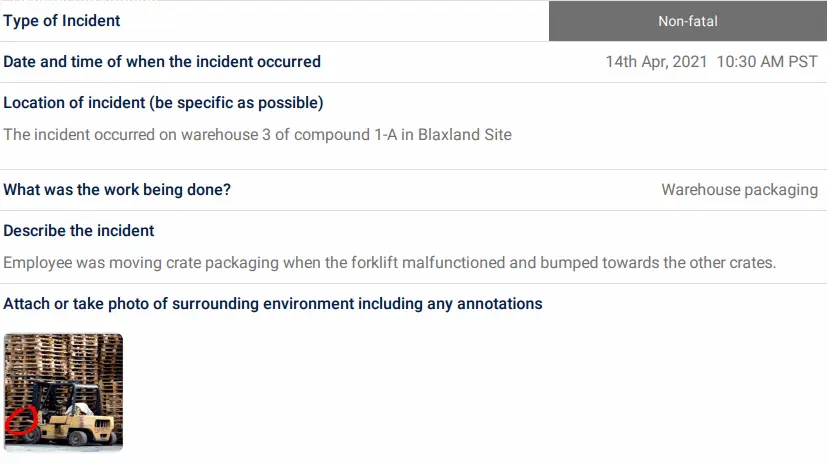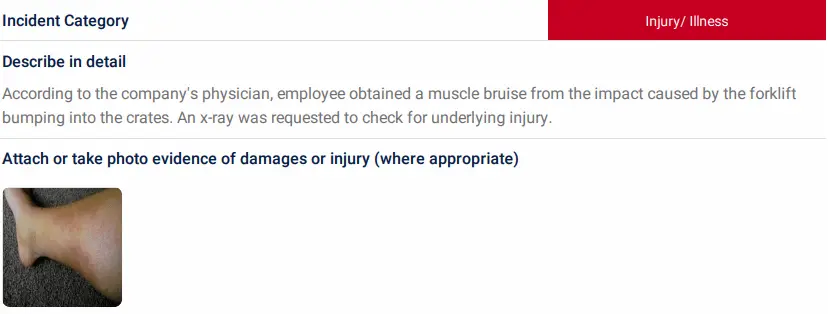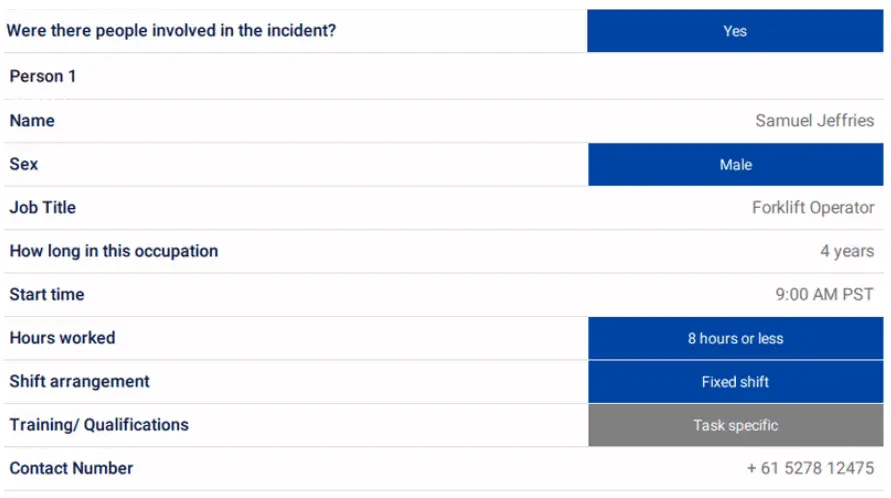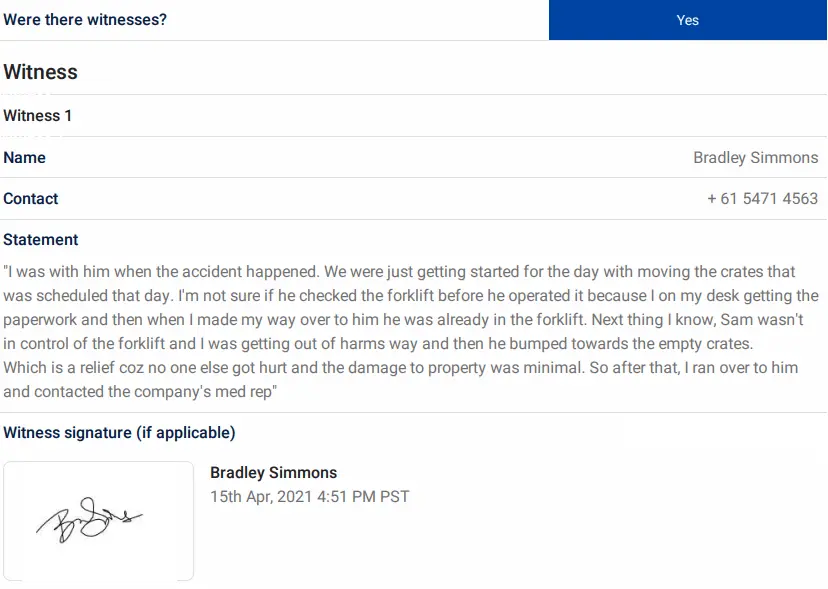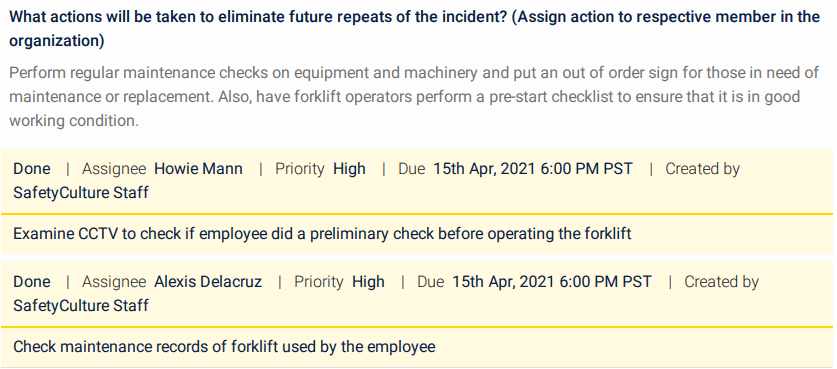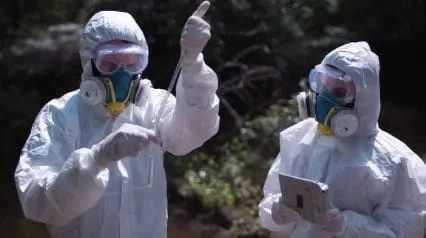What is an Incident Report?
An incident report is a tool that documents any event that may or may not have caused injuries to a person or damage to a company asset. It is used to capture injuries and accidents, near misses, property and equipment damage, health and safety issues, security breaches and misconducts in the worksite.
What is the Purpose of Incident Reporting?
As part of Incident Management, the purpose of incident reporting is to record an incident, determine its possible cause, document any actions taken, and make it known to stakeholders. An incident report can be used in the investigation and analysis of an event or as safety documents that indicate potential risks and uncontrolled hazards found on the work site for future assessments (e.g., ergonomic assessments).
An incident report is utilized by:
- an authority to create a report of an incident;
- a worker to report an incident he/ she has witnessed;
- any member of the organization to raise awareness about an incident that has occurred in the worksite.
Top 3 Benefits of Incident Reporting
The management and their workers should know why incident reporting can not only improve an organization’s safety but also help the business stand out from others and, most importantly, can help create a sound and healthy working environment and culture for workers.
1. Immediate Reinforcement of Actions
In the event that an incident happens at work, documenting and reporting the details to management can induce immediate and necessary measures to be taken (e.g., providing first aid). This also heightens the seriousness and gravity of any incident, reminding all workers that these events should be reported, whether big or small. Immediate action also helps leaders magnify their responsibilities in ensuring a safer place for their workers.
2. Communication on Hazards and Threats
Communicating threats, risks, and hazards to all concerned and affected workers in an organization helps raise awareness of possible dangers that may arise. This could be an essential tool for industries in which tasks are associated with the highest risks, such as the construction, manufacturing, mining industries, and even offices, which are prone to accidents because of the potential hazards that can be overlooked.
3. Continuous Improvement of Processes
An incident report provides a clear picture of what an organization should focus on resolving, changing, improving, or eliminating. This also helps the management implement new policies to determine the efficacy of these changes for safety and quality.
What are the 4 Types of Incident Reports?
Here are 4 types of incidents you should report:
- Sentinel events – these are unexpected occurrences that resulted in serious physical or psychological injury or death (e.g., slips, trips and falls, natural disasters, vehicle accidents, disease outbreak, etc.).
- Worker injury incident
- Environmental incident
- Property damage incident
- Vehicle incident
- Fire incident
- Near misses – these are situations where the people involved had no injuries but could have been potentially harmed by the risks detected.
- Adverse events – related to medicine, vaccines, and medical devices (in compliance with ISO 14971). These events occur when an act of commission or omission harms a patient rather than the existing disease or condition.
- No harm events – these are incidents that need to be communicated across an organization to raise awareness of any harm that may happen.
Additionally, there are two major ways to create a comprehensive incident report: list type and narrative type. List-type reporting allows users to enumerate all the relevant information in a straight-to-the-point approach. Narrative reporting, meanwhile, involves documenting events in a descriptive or storytelling manner. As the keyword suggests, it narrates the whole incident from start to finish.
What to Include in an Incident Report
To ensure an effective incident reporting, it should be accurate, factual, complete, graphic, and valid. Here’s a list of elements that would guide you during the documentation of an incident:
- General information
- Setting or environment
- Affected people
- Injuries and the severity
- Witnesses
- Administered treatment
- Property and equipment damages
- Events
- Actions of people involved during the incident
Take a look at some incident report examples here

Format
The layout of information in an incident report form may vary depending on a number of factors. But should generally include the following elements:
- Introduction – The first part of the incident report form covers the who, what, when, and where of the incident.
- Body – Talk about the incident from start to finish, ensuring details are laid out in chronological order to avoid confusion.
- Conclusion – Was the incident resolved? How? If the incident was not resolved, explain why, and provide the steps that need to be taken in order to resolve it.
- Sign off – Include the full name and signature of the incident report writer for accountability and record-keeping.
Create your own Incident Report Template
Build from scratch or choose from our collection of free, ready-to-download, and customizable templates.
Browse Incident Report TemplatesHow to Write an Incident Report: A Step-by-Step Guide (with Examples)
Now that we have an idea of what information should be included in an incident report, here’s a sample walkthrough through an incident report PDF sample to give you a clearer picture of how you can create an effective incident report.
Step 1: Provide Fundamental Information
Following the outline of an incident report form, the first thing you would want to collect are fundamental information. You can do this by answering the following questions:
- What type of injury was caused, if any? Was it fatal or non-fatal?
- Was there any property damage?
- When and where did it take place?
- What task was being done at the time when the incident occurred?
- What was the environment like?
Using the scenario above, the first section of your report would begin to look something like this:
In our incident report example, we took advantage of adding photo evidence to better illustrate the environment where the incident took place. Notice that the photo attached had an annotation. Annotating gives the reader(s) of your report a clearer idea of what to look at.
Step 2: Take Note of Any Damages and Injuries
The next thing you would want to do is determine the results of the incident. Did it cause any damage or injure anyone? If so, you should describe it in detail and, if appropriate, provide photo evidence of the damage.
Step 3: Identify Affected Individual(s)
Provide the names of the people involved along with their job details, such as title, shift arrangement, and other relevant information.
Step 4: Identify Witnesses and Take Their Statements
Record the names of people present during the incident and gather their statements. These will be valuable in understanding the sequence of events that led to the incident and may even provide you a better insight into whether or not the behavior of the affected employees was a factor that contributed to the injury or damage. Witnesses’ statements can be noted verbatim or paraphrased. Remember to have the witnesses sign off on their statements to verify the accuracy of what has been recorded.
Step 5: Take Action
This refers to the actions that should be taken after the incident. It includes corrective actions that will eliminate recurrence of the incident. The corrective actions section of your incident report can also include the actions that you need to take in order to complete the report.
Step 6: Close Your Report
Upon completion of the previous sections, you may collect management’s comments on the incident. For accountability measures, you, as the reporter, and someone from upper management should sign off. This will validate that the information stated in the incident report is truthful and unquestionable.
See this incident report PDF sample for a comprehensive guide.
Improve your GRC management
Simplify risk management and compliance with our centralized platform, designed to integrate and automate processes for optimal governance.
Explore nowFAQs about Incident Reports
The main difference falls on the one who completes it. A police report is a detailed documentation of a crime written by an officer or any representative of a police department who was present at the crime scene. On the other hand, an incident report can be written by anyone who wants to report any events that might or might not have caused harm to someone or something. Police reports require an investigation to follow, while an incident report can be used as a supporting document for an investigation or analysis of events.
Generally, an incident is defined as any event, condition, or situation which:
- Causes disruption or interference to an organization;
- Causes significant risks that could affect members within an organization;
- Impacts on the systems and operation of worksites; and/ or
- Attracts negative media attention or a negative profile for the worksite
The rule of thumb is that as soon as an incident occurs, an incident report should be completed. Minor injuries should be reported and taken as seriously as major injuries. These injuries may get worse and lead to more serious injuries or health issues if not addressed.

